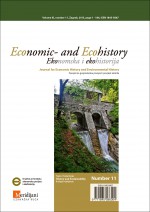Marginal Islands and Sustainability: 2,000 Years of Human Settlement in Eastern Micronesia
Marginal Islands and Sustainability: 2,000 Years of Human Settlement in Eastern Micronesia
Author(s): Frank ThomasSubject(s): Human Ecology, Economic development, Environmental interactions
Published by: Društvo za hrvatsku ekonomsku povijest i ekohistoriju - Izdavačka kuća Meridijani
Keywords: Kiribati; Marshall Islands; historical ecology; conservation;
Summary/Abstract: Low coral islands in the Pacific are often perceived as marginal habitats for human settlement. This view is supported by the small and fragmented islet landmass, poor soils, lack of perennial surface fresh water, and extreme vulnerability to flooding by storm waves, and more recently, rising sea-level attributed to global warming. The atolls and table reefs of Kiribati and the Marshall Islands have produced some of the earliest dates for human settlement of eastern Micronesia. Sustainability for the last 2,000 years was just as likely the result of relatively low population densities, low impact extractive technologies, and efficient use of limited resources, as the application of intentional and unintentional conservation practices.
Journal: Ekonomska i ekohistorija - Časopis za gospodarsku povijest i povijest okoliša
- Issue Year: 2015
- Issue No: 11
- Page Range: 64-74
- Page Count: 11
- Language: English

